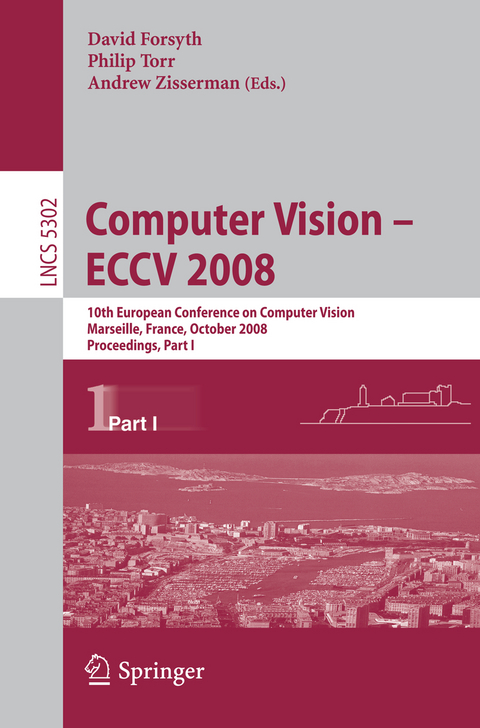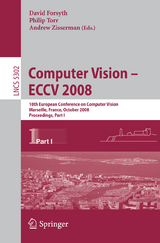Computer Vision - ECCV 2008
Springer Berlin (Verlag)
978-3-540-88681-5 (ISBN)
Lecture by Prof. Jan Koenderink.- Something Old, Something New, Something Borrowed, Something Blue.- Recognition.- Learning to Localize Objects with Structured Output Regression.- Beyond Nouns: Exploiting Prepositions and Comparative Adjectives for Learning Visual Classifiers.- Learning Spatial Context: Using Stuff to Find Things.- Segmentation and Recognition Using Structure from Motion Point Clouds.- Poster Session I.- Keypoint Signatures for Fast Learning and Recognition.- Active Matching.- Towards Scalable Dataset Construction: An Active Learning Approach.- GeoS: Geodesic Image Segmentation.- Simultaneous Motion Detection and Background Reconstruction with a Mixed-State Conditional Markov Random Field.- Semidefinite Programming Heuristics for Surface Reconstruction Ambiguities.- Robust Optimal Pose Estimation.- Learning to Recognize Activities from the Wrong View Point.- Joint Parametric and Non-parametric Curve Evolution for Medical Image Segmentation.- Localizing Objects with Smart Dictionaries.- Weakly Supervised Object Localization with Stable Segmentations.- A Perceptual Comparison of Distance Measures for Color Constancy Algorithms.- Scale Invariant Action Recognition Using Compound Features Mined from Dense Spatio-temporal Corners.- Semi-supervised On-Line Boosting for Robust Tracking.- Reformulating and Optimizing the Mumford-Shah Functional on a Graph - A Faster, Lower Energy Solution.- Viewpoint Invariant Pedestrian Recognition with an Ensemble of Localized Features.- Perspective Nonrigid Shape and Motion Recovery.- Shadows in Three-Source Photometric Stereo.- Hamming Embedding and Weak Geometric Consistency for Large Scale Image Search.- Estimating Geo-temporal Location of Stationary Cameras Using Shadow Trajectories.- An Experimental Comparison of Discrete and Continuous Shape Optimization Methods.- Image Feature Extraction Using Gradient Local Auto-Correlations.- Analysis of Building Textures for Reconstructing Partially Occluded Facades.- NonrigidImage Registration Using Dynamic Higher-Order MRF Model.- Tracking of Abrupt Motion Using Wang-Landau Monte Carlo Estimation.- Surface Visibility Probabilities in 3D Cluttered Scenes.- A Generative Shape Regularization Model for Robust Face Alignment.- Modeling and Recognition of Landmark Image Collections Using Iconic Scene Graphs.- VideoCut: Removing Irrelevant Frames by Discovering the Object of Interest.- ASN: Image Keypoint Detection from Adaptive Shape Neighborhood.- Online Sparse Matrix Gaussian Process Regression and Vision Applications.- Multi-stage Contour Based Detection of Deformable Objects.- Brain Hallucination.- Range Flow for Varying Illumination.- Some Objects Are More Equal Than Others: Measuring and Predicting Importance.- Robust Multiple Structures Estimation with J-Linkage.- Human Activity Recognition with Metric Learning.- Shape Matching by Segmentation Averaging.- Search Space Reduction for MRF Stereo.- Estimating 3D Face Model and Facial Deformation from a Single Image Based on Expression Manifold Optimization.- 3D Face Recognition by Local Shape Difference Boosting.- Efficiently Learning Random Fields for Stereo Vision with Sparse Message Passing.- Recovering Light Directions and Camera Poses from a Single Sphere.- Tracking with Dynamic Hidden-State Shape Models.- Interactive Tracking of 2D Generic Objects with Spacetime Optimization.- A Segmentation Based Variational Model for Accurate Optical Flow Estimation.- Similarity Features for Facial Event Analysis.- Building a Compact Relevant Sample Coverage for Relevance Feedback in Content-Based Image Retrieval.- Discriminative Learning for Deformable Shape Segmentation: A Comparative Study.- Discriminative Locality Alignment.- Stereo.- Efficient Dense Scene Flow from Sparse or Dense Stereo Data.- Integration of Multiview Stereo and Silhouettes Via Convex Functionals on Convex Domains.- Using Multiple Hypotheses to Improve Depth-Maps for Multi-View Stereo.- Sparse Structures in L-Infinity Norm Minimization for Structure and Motion Reconstruction.
| Erscheint lt. Verlag | 7.10.2008 |
|---|---|
| Reihe/Serie | Image Processing, Computer Vision, Pattern Recognition, and Graphics | Lecture Notes in Computer Science |
| Zusatzinfo | XXXVII, 801 p. |
| Verlagsort | Berlin |
| Sprache | englisch |
| Maße | 155 x 235 mm |
| Gewicht | 1251 g |
| Themenwelt | Informatik ► Datenbanken ► Data Warehouse / Data Mining |
| Schlagworte | Action Recognition • aerial imagery • algorithms • Computervision • Edge Detection • Hardcover, Softcover / Informatik, EDV/Informatik • HC/Informatik, EDV/Informatik • Motion Capture • multi body tracking • multi camera • multi-modal sensors • photography • radiance • Segmentation • Stereo Matching • supervised learning • surface matching • surface reconstruction • visually impaired |
| ISBN-10 | 3-540-88681-8 / 3540886818 |
| ISBN-13 | 978-3-540-88681-5 / 9783540886815 |
| Zustand | Neuware |
| Haben Sie eine Frage zum Produkt? |
aus dem Bereich




